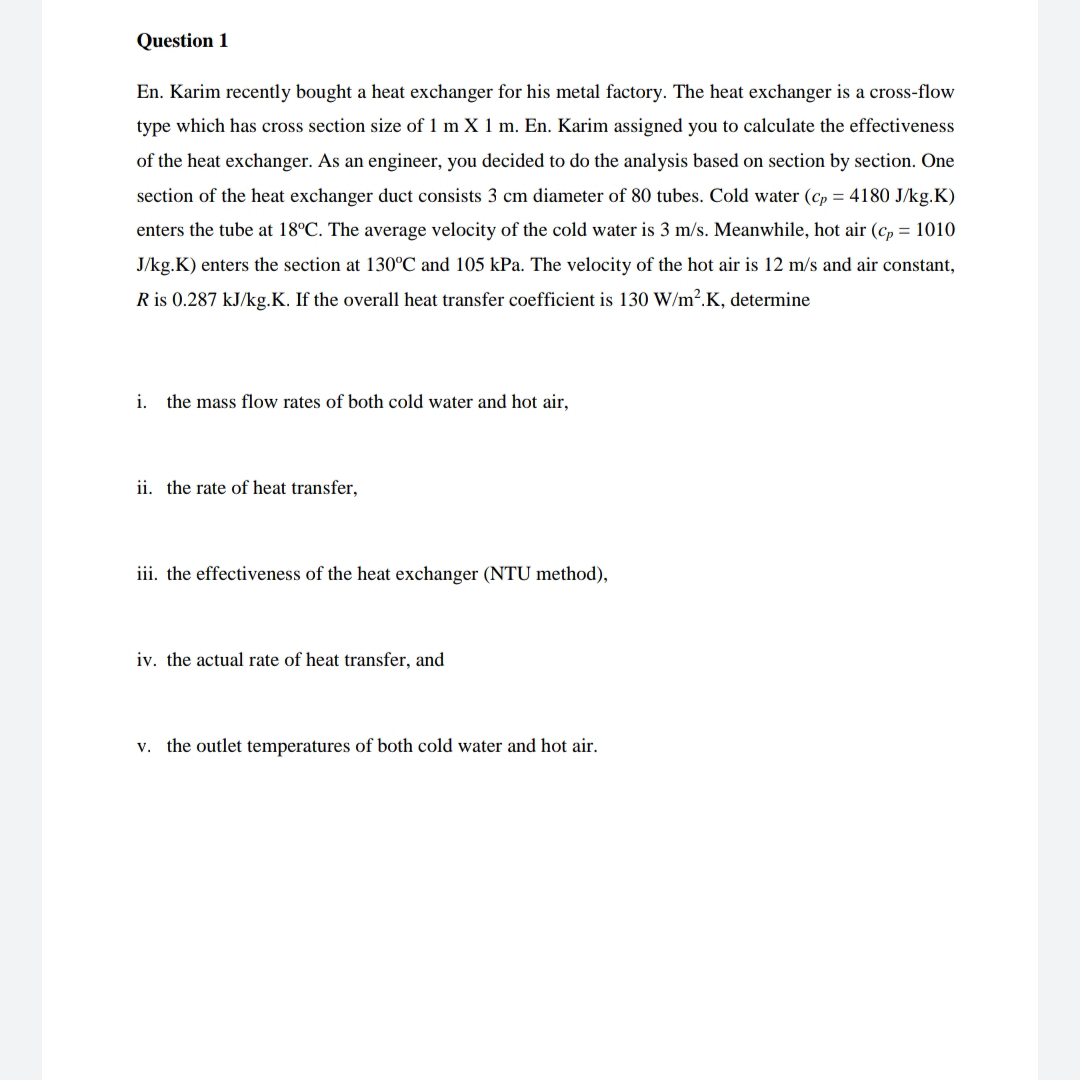Question 1 En. Karim recently bought a heat exchanger for his metal factory. The heat exchanger is a cross-flow type which has cross section size of 1 m X 1 m. En. Karim assigned you to calculate the effectiveness of the heat exchanger. As an engineer, you decided to do the analysis based on section by section. One section of the heat exchanger duct consists 3 cm diameter of 80 tubes. Cold water (cp = 4180 J/kg.K) enters the tube at 18°C. The average velocity of the cold water is 3 m/s. Meanwhile, hot air (c, = 1010 %3D J/kg.K) enters the section at 130°C and 105 kPa. The velocity of the hot air is 12 m/s and air constant, R is 0.287 kJ/kg.K. If the overall heat transfer coefficient is 130 W/m2.K, determine i. the mass flow rates of both cold water and hot air, ii. the rate of heat transfer, iii. the effectiveness of the heat exchanger (NTU method), iv. the actual rate of heat transfer, and v. the outlet temperatures of both cold water and hot air.
Question 1 En. Karim recently bought a heat exchanger for his metal factory. The heat exchanger is a cross-flow type which has cross section size of 1 m X 1 m. En. Karim assigned you to calculate the effectiveness of the heat exchanger. As an engineer, you decided to do the analysis based on section by section. One section of the heat exchanger duct consists 3 cm diameter of 80 tubes. Cold water (cp = 4180 J/kg.K) enters the tube at 18°C. The average velocity of the cold water is 3 m/s. Meanwhile, hot air (c, = 1010 %3D J/kg.K) enters the section at 130°C and 105 kPa. The velocity of the hot air is 12 m/s and air constant, R is 0.287 kJ/kg.K. If the overall heat transfer coefficient is 130 W/m2.K, determine i. the mass flow rates of both cold water and hot air, ii. the rate of heat transfer, iii. the effectiveness of the heat exchanger (NTU method), iv. the actual rate of heat transfer, and v. the outlet temperatures of both cold water and hot air.
Principles of Heat Transfer (Activate Learning with these NEW titles from Engineering!)
8th Edition
ISBN:9781305387102
Author:Kreith, Frank; Manglik, Raj M.
Publisher:Kreith, Frank; Manglik, Raj M.
Chapter10: Heat Exchangers
Section: Chapter Questions
Problem 10.18P
Related questions
Concept explainers
Heat Exchangers
Heat exchangers are the types of equipment that are primarily employed to transfer the thermal energy from one fluid to another, provided that one of the fluids should be at a higher thermal energy content than the other fluid.
Heat Exchanger
The heat exchanger is a combination of two words ''Heat'' and ''Exchanger''. It is a mechanical device that is used to exchange heat energy between two fluids.
Question

Transcribed Image Text:Question 1
En. Karim recently bought a heat exchanger for his metal factory. The heat exchanger is a cross-flow
type which has cross section size of 1 m X 1 m. En. Karim assigned you to calculate the effectiveness
of the heat exchanger. As an engineer, you decided to do the analysis based on section by section. One
section of the heat exchanger duct consists 3 cm diameter of 80 tubes. Cold water (cp = 4180 J/kg.K)
enters the tube at 18°C. The average velocity of the cold water is 3 m/s. Meanwhile, hot air (cp = 1010
J/kg.K) enters the section at 130°C and 105 kPa. The velocity of the hot air is 12 m/s and air constant,
R is 0.287 kJ/kg.K. If the overall heat transfer coefficient is 130 W/m².K, determine
i. the mass flow rates of both cold water and hot air,
ii. the rate of heat transfer,
iii. the effectiveness of the heat exchanger (NTU method),
iv. the actual rate of heat transfer, and
v. the outlet temperatures of both cold water and hot air.
Expert Solution
This question has been solved!
Explore an expertly crafted, step-by-step solution for a thorough understanding of key concepts.
Step by step
Solved in 5 steps with 5 images

Knowledge Booster
Learn more about
Need a deep-dive on the concept behind this application? Look no further. Learn more about this topic, mechanical-engineering and related others by exploring similar questions and additional content below.Recommended textbooks for you

Principles of Heat Transfer (Activate Learning wi…
Mechanical Engineering
ISBN:
9781305387102
Author:
Kreith, Frank; Manglik, Raj M.
Publisher:
Cengage Learning

Principles of Heat Transfer (Activate Learning wi…
Mechanical Engineering
ISBN:
9781305387102
Author:
Kreith, Frank; Manglik, Raj M.
Publisher:
Cengage Learning